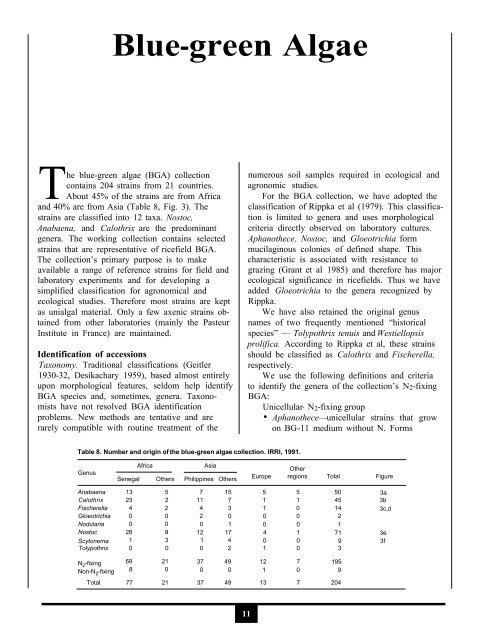Azolla - IRRI books - International Rice Research Institute
Azolla - IRRI books - International Rice Research Institute
Azolla - IRRI books - International Rice Research Institute
- No tags were found...
You also want an ePaper? Increase the reach of your titles
YUMPU automatically turns print PDFs into web optimized ePapers that Google loves.
Blue-green AlgaeThe blue-green algae (BGA) collectioncontains 204 strains from 21 countries.About 45% of the strains are from Africaand 40% are from Asia (Table 8, Fig. 3). Thestrains are classified into 12 taxa. Nostoc,Anabaena, and Calothrix are the predominantgenera. The working collection contains selectedstrains that are representative of ricefield BGA.The collection’s primary purpose is to makeavailable a range of reference strains for field andlaboratory experiments and for developing asimplified classification for agronomical andecological studies. Therefore most strains are keptas unialgal material. Only a few axenic strains obtainedfrom other laboratories (mainly the Pasteur<strong>Institute</strong> in France) are maintained.Identification of accessionsTaxonomy. Traditional classifications (Geitler1930-32, Desikachary 1959), based almost entirelyupon morphological features, seldom help identifyBGA species and, sometimes, genera. Taxonomistshave not resolved BGA identificationproblems. New methods are tentative and arerarely compatible with routine treatment of thenumerous soil samples required in ecological andagronomic studies.For the BGA collection, we have adopted theclassification of Rippka et al (1979). This classificationis limited to genera and uses morphologicalcriteria directly observed on laboratory cultures.Aphanothece, Nostoc, and Gloeotrichia formmucilaginous colonies of defined shape. Thischaracteristic is associated with resistance tograzing (Grant et al 1985) and therefore has majorecological significance in ricefields. Thus we haveadded Gloeotrichia to the genera recognized byRippka.We have also retained the original genusnames of two frequently mentioned “historicalspecies” — Tolypothrix tenuis and Westiellopsisprolifica. According to Rippka et al, these strainsshould be classified as Calothrix and Fischerella,respectively.We use the following definitions and criteriato identify the genera of the collection’s N 2 -fixingBGA:Unicellular- N 2 -fixing group• Aphanothece— unicellular strains that growon BG-11 medium without N. FormsTable 8. Number and origin of the blue-green algae collection. <strong>IRRI</strong>, 1991.GenusAfricaAsiaSenegal Others Philippines OthersOtherEurope regions Total FigureAnabaena 13 5 7 15 5 5 503aCalothrix 23 2 11 7 1 1 45 3bFischerella 4 2 4 3 1 0 143c,dGloeotrichia 0 0 2 0 0 0 2Nodularia 0 0 0 1 0 0 1Nostoc 28 9 12 17 4 1 71 3eScytonema 1 3 1 4 0 0 9 3fTolypothrix 0 0 0 2 1 0 3N 2 -fixing 69 21 37 49 12 7 195Non-N 2 -fixing 8 0 0 0 1 0 9Total 77 21 37 49 13 7 20411
















